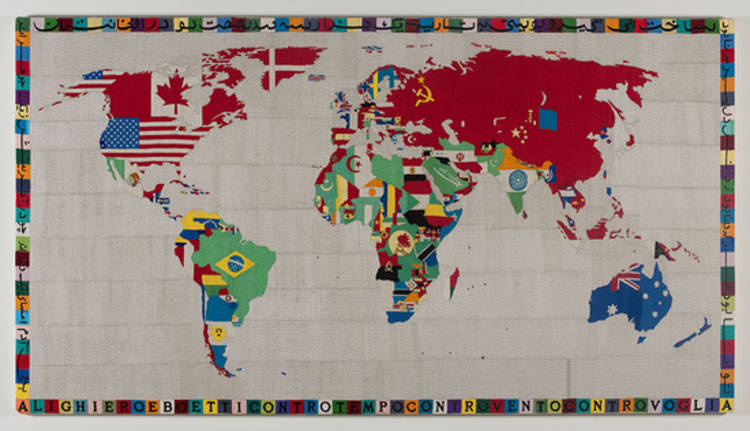


It was November 1967, two months after his exhibition “Arte Povera e IM Spazio” at Genoa’s Galleria La Bertesca, that the Italian critic Germano Celant [2] published a manifesto on Flash Art magazine that would theorize and launch the Arte Poveramovement.
The Origins
Literally translated as ‘poor art’, the title refers to a group of Italian anti-establishment artists who, during the period of turmoil at the end of the 1960s in Italy, attacked the established ideals and the superficial consumer culture with unconventional materials and style.
The term “poor” was not an indication of cheap, rather a reference to the artists’ use of humble, unconventional often ephemeral materials -wood, dirt, rags, steel, sacks, vegetables- alluding as well to the Polish director Jerzy Grotowski’s concept of “poor theater,” which stripped away lavish costumes and detailed sets and encouraged the actor’s relationship with the audience.
The poveristi favored an art form that was more conceptual and got rid of unnecessary layers, as a rejection of traditional 'high' art. “Arte Povera was concerned with taking away, eliminating, and downgrading things to a minimum,” said Mr. Celant.
Among the core figures associated with the movement are Giovanni Anselmo [3], Alighiero Boetti [4], Jannis Kounellis [5], Michelangelo Pistoletto [6], Giuseppe Penone [7], Alberto Burri [8], Lucio Fontana [9], Emilio Prini [10], Pino Pascali [11], Enrico Castellani [12], Piero Manzoni [13], Luciano Fabro [14], Pier-Paolo Calzolari [15], Mario Merz [16], and his wife Marisa Merz [17], the only female member of Arte Povera.
The Resurgence: From New York to Europe
After the Arte Povera exhibition at MoMA [18]PS1 in 1985, they fell under the radar, until in recent years they regained international acclaim. In fact, in 2015, Alberto Burri was the protagonist of a major retrospective at New York's Guggenheim [19] (the last one he had there was in 1978) along with several gallery shows in major cities. This initiated a substantial revival of the movement.
A little over a year later, the Met Breuer [20] presented the first major retrospective in the United States of Marisa Mertz, followed by the opening of Magazzino Italian Art [21], a new exhibition space for Italian postwar art in Cold Spring. Their first exhibition was dedicated to the influence and legacy of Margherita Stein, an Italian dealer who dedicated her career to supporting artists from the Arte Povera.
Exactly fifty years from its inception, Arte Povera seems to have reached its zenith, both in Italy and abroad. The 2017 Turin's Artissima Art Fair [22] featured two special projects that paid tribute to Arte Povera, “the Piper Club” and the “Deposito d’Arte Presente.” Castello Rivoli of Turin [23] unveiled a major retrospective devoted to the work of Gilberto Zorio and the MAXXI museum of 21st Century Arts [24] in Rome presented an exhibition on Piero Gilardi, artist associated with the early Arte Povera movement. Additionally, for the occasion, the Estorick Collection in London [25] had an exhibition on the Italian movement while exploring it’s influence on the contemporary world.
Simultaneously, on the opposite side of the Atlantic, the celebration of the midcentury movement continues. Luxembourg & Dayan [26], Hauser & Wirth [27], Luhring Augustine Gallery [28] and Lévy Gorvy Gallery New York [29] amongst others presented exhibitions that commemorated the semi-centennial of the Arte Povera movement. Along with the several exhibitions, Magazzino Italian Art hosted one of the leading member of the Arte Povera movement, Michelangelo Pistoletto for a re-enactment of his 1967 performance "Scultura da Passeggio" (Walking Sculpture) [30] captivating all who came into contact with it.
It’s hard to differentiate whether recent attention to Arte Povera comes from the movement’s 50th anniversary, the sociopolitical conditions or the rising prices within the art market. No matter the reason, after decades of insubstantial support the poveristi are finally getting the recognition they deserve, as their work never ceased to be relevant.
Source URL: http://ftp.iitaly.org/magazine/article/celebrating-50-years-arte-povera-0
Links
[1] http://ftp.iitaly.org/files/boettijpg
[2] https://en.wikipedia.org/wiki/Germano_Celant
[3] https://en.wikipedia.org/wiki/Giovanni_Anselmo
[4] https://en.wikipedia.org/wiki/Alighiero_Boetti
[5] https://en.wikipedia.org/wiki/Jannis_Kounellis
[6] https://en.wikipedia.org/wiki/Michelangelo_Pistoletto
[7] https://en.wikipedia.org/wiki/Giuseppe_Penone
[8] https://en.wikipedia.org/wiki/Alberto_Burri
[9] https://en.wikipedia.org/wiki/Lucio_Fontana
[10] https://en.wikipedia.org/wiki/Emilio_Prini
[11] https://en.wikipedia.org/wiki/Pino_Pascali
[12] https://en.wikipedia.org/wiki/Enrico_Castellani
[13] https://en.wikipedia.org/wiki/Piero_Manzoni
[14] https://en.wikipedia.org/wiki/Luciano_Fabro
[15] http://www.artnet.com/artists/pier-paolo-calzolari/
[16] https://en.wikipedia.org/wiki/Mario_Merz
[17] https://en.wikipedia.org/wiki/Marisa_Merz
[18] https://www.moma.org
[19] https://www.guggenheim.org/about-us
[20] https://www.metmuseum.org/visit/met-breuer
[21] http://www.magazzino.art
[22] http://www.artissima.it/site/?lang=en
[23] https://www.castellodirivoli.org/en/
[24] http://http://www.maxxi.art/en/
[25] http://www.estorickcollection.com
[26] http://www.luxembourgdayan.com
[27] https://www.hauserwirth.com
[28] http://www.luhringaugustine.com
[29] https://www.levygorvy.com
[30] http://www.magazzino.art/events/michelangelo-pistoletto-walking-sculpture-performance